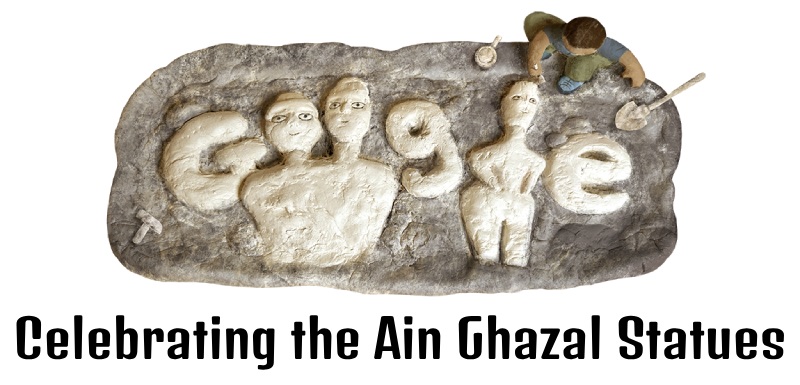Festivals & Events
Interesting and Amazing Facts about the Ain Ghazal Statues

The about 9,000-year-old Ain Ghazal statues are recognized as one of the earliest significant representations of the human form, and today’s hand-crafted Google Doodle honors them. The statues were found on September 30, 1983, in Jordan. Here are some interesting and amazing quick facts about Ain Ghazal statues.
Quick Facts
- Material: Plaster and reed
- Size: 32 items
- Created: Between 7200 BC and 6250 BC
- Discovered: 1983,ʿAin Ghazal, Amman, Jordan
- Present location: The Jordan Museum
Interesting Facts about the Ain Ghazal Statues
- The ‘Ain Ghazal Statues’ are several enormous lime plaster and reed statues from the Pre-Pottery Neolithic C period that were created between 7200 BC and 6250 BCE and were found at the ‘Ain Ghazal’ archeological site in Jordan. They date back to about 9000 years ago.
- In two underground caches that were made around 200 years apart, a total of 15 statues and 15 busts were found in 1983 and 1985.
- The statues are thought to be among the most impressive examples of prehistoric art from the Pre-Pottery Neolithic B or C period. They are among the oldest large-scale representations of the human figure.
- Archaeologists think they may have been buried shortly after being built, possibly with that intention, but their purpose is still unknown.
- The Ain Ghazal Statues are now included in the holdings of The Jordan Museum in Amman, with some also on display at the Jordan Archaeological Museum of the Amman Citadel.
- A few of the statues have also been loaned to foreign museums: one statue is in the Louvre Museum in Paris; parts of three other statues are on display at the British Museum in London; and one of the figures with two heads is on display at the Louvre Abu Dhabi.
- There are two different kinds of figures: full statues and busts. There are some two-headed busts. The heads were meticulously modeled, with wide-open eyes and irises that were outlined in bitumen.
- The statues show men, women, and children; women can be distinguished by breast-like features and slightly enlarged bellies; none of the statues have genitalia; the only aspect of the statues that has any level of detail is the faces.
- The statues were created by molding damp limestone plaster onto a core of reed with the help of vegetation that grew along the Zarqa River’s banks.
- The tallest statues reach heights of about 1 m (3 ft), making them taller than figurines or statuettes but still not human-sized.
- Since the statues were buried in perfect condition, it is probable that they were never on display for very long and were instead built with the idea of being intentionally buried. The manner the statues were made would not have allowed them to last for very long.
- Ain Ghazal’s location was discovered in 1974 by contractors working on a roadway between Amman and Zarqa. Extraction started in 1982. The area was inhabited between 7250 and 5000 BC.
- The settlement had a golden period in the first part of the seventh millennium BC when it covered 10-15 hectares (25-37 acres) and housed about 3000 people.
- In 1983, the statues were found. Archaeologists discovered the edge of a sizable hole with plaster figurines 2.5 meters (8 feet) below the surface while investigating a cross-section of the dirt in a bulldozer-cut path.
- Gary O. Rollefson oversaw the excavation in 1984–1985, and he and Zeidan Kafafi oversaw a second round of excavation in 1993–1996.
- There were two caches with a combined total of 15 statues and 15 busts, over 200 years apart. They are remarkably well-preserved because they were placed meticulously in pits cut into the flooring of abandoned homes. Only fragmented remains of such statues discovered in Jericho and Nahal Hemar have persisted.
- The statues’ discovery pit was meticulously excavated, and its contents were put in a wooden box filled with polyurethane foam for shipping safety. Plaster, which the statues are composed of, is brittle, especially after being buried for so long.
- The Royal Archaeological Institute in Great Britain received the first set of sculptures unearthed at the location, while the second set, discovered a few years later, was transported to the Smithsonian Institution in New York for restoration.
- After being restored, the statues were given back to Jordan and are now on display in the Jordan Museum.
- The British Museum is loaning out part of the treasure. One statue is on loan to the Louvre Museum in Paris, and the Louvre Abu Dhabi is displaying one of the statues with two heads.
- To contemplate the mysteries of the past, the statues can now be seen in museums like the British Museum, Louvre Abu Dhabi, Jordan Museum, and Jordan Archaeological Museum.
- On September 30, 2023, Google displayed a Google Doodle in honor of the Ain Ghazal statues on its homepage.
-

 Business3 weeks ago
Business3 weeks agoPrakash and Kamal Hinduja: Driving Social and Environmental Change
-
Education4 weeks ago
Fred DuVal: University Leadership as a Critical Resource for Climate Change Research and Life-Saving Solutions
-

 Health3 weeks ago
Health3 weeks agoThe Hinduja Brothers Commitment to Global Health: Empowering Communities Across Borders
-

 Cryptocurrency3 weeks ago
Cryptocurrency3 weeks agoDesigned For The Masses: How Akasha (AK1111) Is Unlocking Crypto For The Next Billion Users
-

 Cryptocurrency4 weeks ago
Cryptocurrency4 weeks agoNexaglobal & Future World Token (FWT): Could This Be the Next Big Crypto Investment of 2025?
-

 Sports4 weeks ago
Sports4 weeks agoWomen’s NCAA Tournament 2025 Sweet 16: Full Schedule, Fixtures, Teams, Bracket, and How to Watch March Madness Basketball Match Live
-

 Startup2 weeks ago
Startup2 weeks agoCost-Saving Strategies Every Small Business Owner Should Know to Boost Efficiency
-

 Startup3 weeks ago
Startup3 weeks agoMatthew Denegre on the Art of Deal Sourcing: Finding the Right Investment Opportunities























